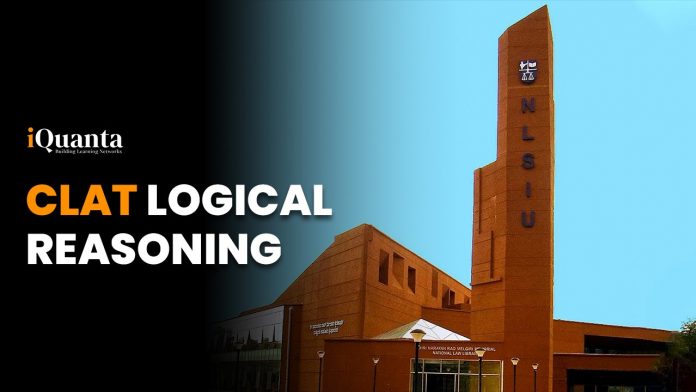The Consortium of National Law University conducts the CLAT Exam for admissions in various UG and PG Law Programs in India. This article will guide you through the CLAT Logical Reasoning Syllabus, Pattern, and Important Topics for Logical Reasoning along with sectional strategy.

The CLAT exam consists of 5 sections-
- CLAT English Language
- CLAT Current Affairs & GK
- CLAT Legal Reasoning
- CLAT Logical Reasoning
- CLAT Quantitative Techniques.
Each section requires focus and determination to ace it in the CLAT Exam.
CLAT Logical Reasoning: Overview
CLAT Logical Reasoning Section consists of analytical and critical reasoning questions based on passages of about 300 words each. The Logical Reasoning Section has a weightage of around 20% in the CLAT Exam. Candidates can expect around 22-26 questions from the CLAT Logical Reasoning Section, that will test the reasoning skills and ability of candidates to infer, analyze, and reach conclusions to solve the questions.
The logical reasoning section might be one of the most unpredictable sections in the CLAT exam and a very integral part of the CLAT Preparation. Here, theoretical learning is not of much use; one is suggested to go for application-based learning.
To know the Eligibility Criteria for the CLAT exam visit CLAT Exam Eligibility
CLAT Logical Reasoning: Exam Pattern
CLAT Logical Reasoning Section consists of short passages of 300-500 words each. For each passage, there will be questions following the passages. The questions that will be asked will be of multiple-choice objective type. Each passage should be completed within 10-20 minutes or candidates can lose time for the other sections. The Logical Reasoning Section will test the candidate’s ability to infer analogies, and logical arguments and draw suitable conclusions.
| Particulars | Logical Reasoning Pattern |
|---|---|
| Type Of Questions | MCQs |
| Total Questions | 22-26 Questions |
| Total Marks | 22-26 Marks |
| Total Weightage | Around 20% |
| Correct Answer | +1 Marks |
| Wrong Answer | -0.25 Marks |
CLAT Logical Reasoning: Important Topics
This section measures the ability to analyze patterns, and logical links, and rectify illogical arguments. It includes a variety of logical reasoning questions, such as syllogisms, logical sequences, analogies, etc.
| 1. Arrangements | 9. Direct Sense |
| 2. Syllogisms | 10. Coding-Decoding |
| 3. Blood Relations | 11. Analogies |
| 4. Number Series | 12. Coding-Decoding |
| 5. Statements and Assumptions | 13. Connectives |
| 6. Logical Sequences | 14. Linear /Circular Arrangement |
| 7. Arguments & Conclusions | 15. Puzzles |
| 8. Assertions and Reasoning | 16. Passages based on Critical Reasoning |
Also Read: NLU Placements of all the NLUs
CLAT Logical Reasoning Preparation Tips
CLAT Logical Reasoning examines your understanding of critical analysis and identification of arguments. This section has been moderately easy to difficult in recent years. Understanding the rationale and logic behind each type of question is crucial to providing your best effort on this paper. Here we have mentioned a few preparation tips that will help you in CLAT Logical reasoning preparation:
- This section is not theoretical in nature, rather it’s analytical. For every question, you will have to understand the logic behind it. The questions might be tricky and you need to have a clear logical mind with which you can address the questions and come up with a solution.
- In CLAT question papers, logical reasoning and quantitative techniques require a lot of practice to make the individual ready for the actual exam. Each question has a logic behind it which needs to be found and solved by the Test-takers. With practice, this section gets easier to solve.
- Always start with the passage you find easier and can cover up within a limited time.
- While solving, start by recognizing an argument, its premises, and conclusions; Read and identify the arguments set out in the passage.
- Critically analyse patterns of reasoning, and assess how conclusions may depend on particular premises or evidence, and how conclusions may be strengthened or weakened as a consequence of an alteration in premises or supporting facts.
- Infer what follows from the passage and apply these inferences to new situations; Draw relationships and analogies, identify contradictions and equivalence, and assess the effectiveness of arguments.
CLAT Logical Reasoning: Sample Questions
Words remain an enigma, their presence within the human sphere is a unique mystery. They form the intricate tapestry that convinces us of our existence, blurring lines between fact and fiction. An engagement with words is the most captivating, enchanting, and sometimes daunting encounter with the world. A word, a symbolic entity formed from the ethereal, exists neither as animate nor inanimate, yet pulsates with life. It can emanate warmth or coldness, absorb emotions, or stand as dry as a rock. Words can provoke smiles and elicit joy. they are like glowworms, momentarily dispelling the surrounding darkness and act as life-saving rafts amid the tumultuous ocean waves. Words grant us the ability to explore the universe, and “to see a world in a grain of sand.” as William Blake noted. they impart a semantic existence to the lifeless, and bestow aesthetic form upon the formless. Scriptures say the word is the world. I say the world within the word is the abode of faith.
Ques(1) What is the central theme of the passage?
(A) the history of the human language
(B) the impact of words on human existence
(C) the importance of storytelling
(D) the mystery of human cognition
[spbcta_sc id=23]
Ques(2) According to the passage, what does a ‘word’ symbolize?
(A) An inanimate object
(b) An animate entity
(C) A tangible entity
(d) An intangible concept
[spbcta_sc id=24]
Ques(3) How does the passage describe words’ ability to affect emotions?
(A) Words can only evoke positive emotions.
(B) Words can absorb emotions and become emotions themselves.
(C) Words have no impact on emotions.
(D) Words can be devoid of emotions.
[spbcta_sc id=23]
Ques(4) “An engagement with words is the most captivating, enchanting, and sometimes daunting encounter with the world.” Which of the following conclusions can be drawn from the above statement?
(A) Words can be used to manipulate others.
(B) the power of words should be used carefully.
(C) Words can capture the atrocities of the world.
(D) Words can paint a picture of the world in all its different colors.
[spbcta_sc id=24]
Ques(5) Which of the following strengthens the author’s idea of words being “like glow-worms momentarily dispelling the surrounding darkness”?
(A) Words help in understanding reality.
(B) Words illuminate the mind of the reader.
(C) Words help in escaping reality.
(D) Words cast darkness in the mind of the reader.
[spbcta_sc id=21]
Ques(6) In the context of the passage, what is the significance of the “world within the word”?
(A) it refers to the power of language to create inspiration, energy, and faith.
(B) It signifies the author’s love for the global community.
(C) it represents the mysteries hidden in language.
(D) it describes the author’s mission to explore different cultures
[spbcta_sc id=21]
Also Read: Law Entrance Exams in India
Where to Start Preparing for CLAT?
Aiming for an exam like CLAT requires you to be consistent and determined with your preparation. Get the right mentorship and 24*7 doubt-solving support from our top CLAT Mentors. Ace your CLAT with iQuanta’s CLAT Online Coaching.
Wishing you all the best in your CLAT journey!


